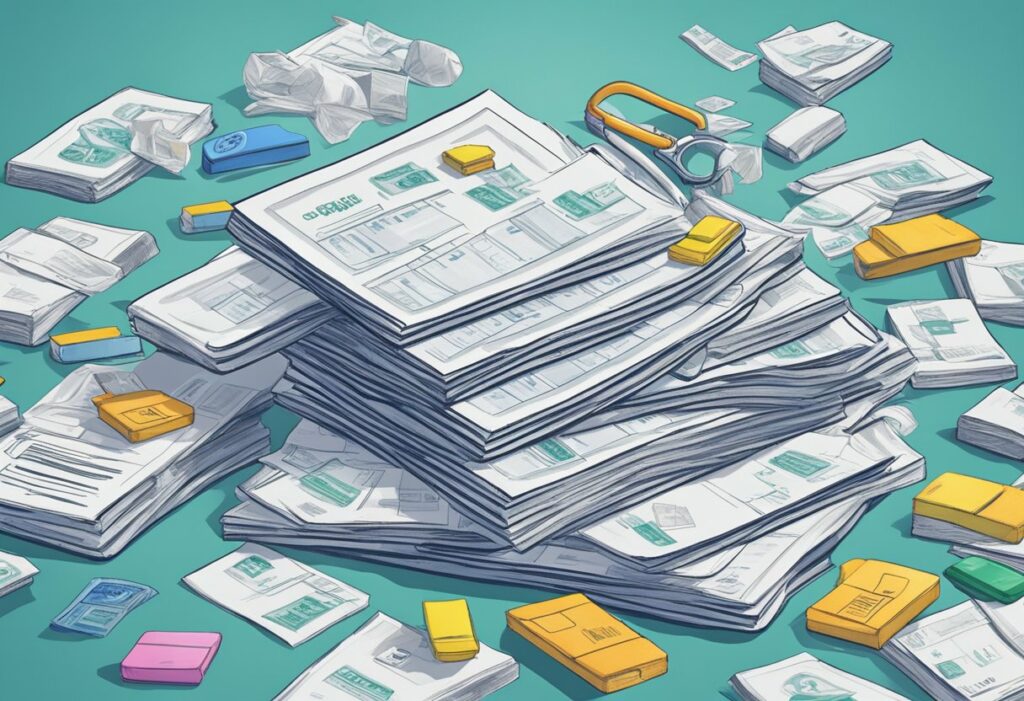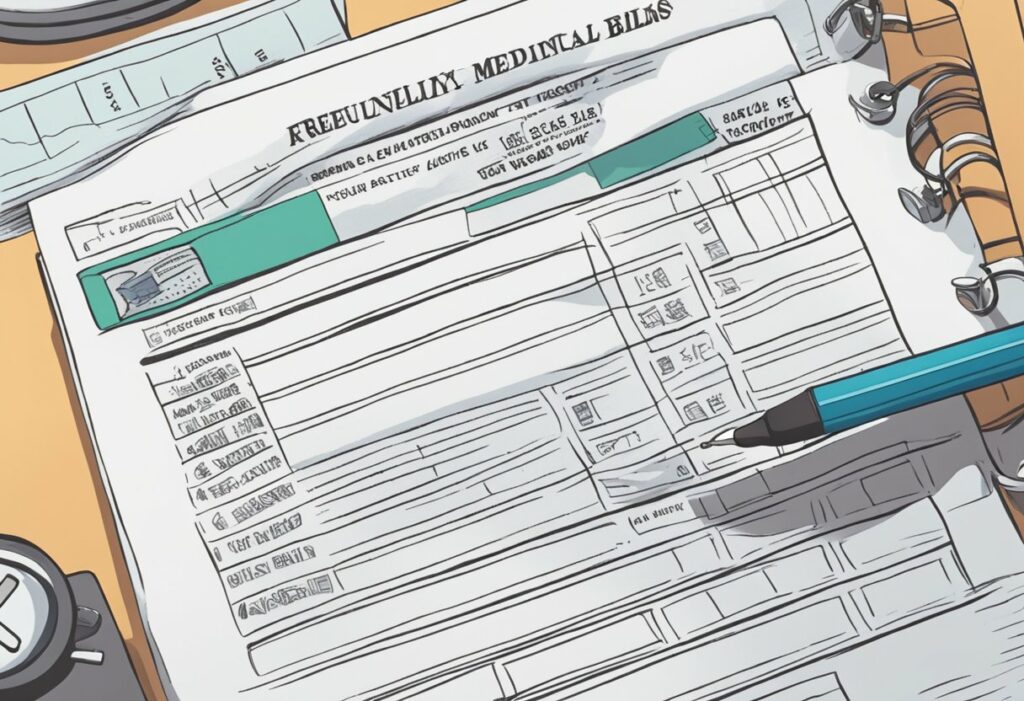Medical bills can be overwhelming, often leaving patients uncertain about how to proceed. There are, however, strategies that can be applied to reduce or even erase medical debt that are not widely known. As healthcare costs continue to rise, understanding your medical bills and health insurance coverage is crucial to managing expenses. Armed with the right knowledge and tools, you can take control of your financial health and work towards a more secure financial future.
Negotiating medical debt might seem daunting, but it’s a practical step that can lead to substantial savings. Medical providers may be open to discussion and can offer reductions or payment plans that accommodate the patient’s financial situation. Additionally, there are assistance programs available that cater to those who are struggling to pay their bills, offering various forms of financial support and solutions tailored to individual needs.
Key Takeaways
- Understanding health insurance and medical billing is key in managing healthcare expenses.
- Negotiation can lead to reduced medical debts and more manageable payment arrangements.
- Various assistance programs can offer financial relief to those burdened by medical bills.
Understanding Your Medical Bills and Health Insurance
Navigating the intricacies of medical bills and health insurance can be challenging. This section aims to empower patients by elucidating the complexities of itemized bills, insurance coverage, and identifying potential errors.
Decoding Itemized Bills and Explanation of Benefits (EOB)
When patients receive healthcare services, they are often given an itemized bill, which lists each service provided and its cost. Subsequently, the patient’s insurance company provides an Explanation of Benefits (EOB), which details the amounts billed, the rates negotiated by the insurance, what the insurance has paid, and what the patient owes, including deductibles and copays. It is crucial for patients to review the EOB carefully to understand their financial responsibility.
The Role of Insurance Coverage and Deductibles
Insurance coverage significantly influences out-of-pocket expenses. Each insurance plan includes various types of coverage with rules dictating the services that are covered, the amount of deductibles, and the copay rates. Generally, the deductible is the sum the patient must pay before the insurance starts covering costs. Once the deductible is met, the insurance may pay a significant portion of the remaining costs.
Identifying Billing Errors and Overcharges
Patients should meticulously review their itemized bills and EOB for any errors or overcharges. Common issues include charges for services never received or duplicate billing. Such errors, if spotted, should be promptly reported to the healthcare provider or insurance company. By vigilantly assessing bills and EOB statements, patients can prevent overpaying and ensure their bills reflect the care received.
Negotiating and Reducing Medical Debt
Navigating the complexities of medical billing can be daunting, but with targeted negotiation tactics and knowledge of the healthcare market, patients can effectively reduce medical debt.
Effective Negotiation Strategies With Providers
When patients face high medical bills, negotiating directly with providers is a critical first step. They should request an itemized bill and scrutinize it for any errors or overcharges, which can be more common than one might think. It is essential to approach the negotiation politely and informed, ready to discuss potential payment plans or reduced charges. Providers are often open to negotiation, knowing that some reimbursement is preferable to potential non-payment.
Leveraging Healthcare Bluebook and Fair Health for Better Rates
Utilizing resources like the Healthcare Bluebook and Fair Health empowers patients to understand fair market prices for medical services. They can utilize this information to advocate for themselves by comparing the prices they’ve been charged to the average rates in their area. Armed with these benchmarks, patients can more persuasively argue for a reduction in their medical debt.
Seeking Discounts for Uninsured and Underinsured Patients
For the uninsured and underinsured, many providers offer discounts. Patients should inquire about discount programs or charity care options, especially if their income falls below a certain threshold. These discounts are not always advertised, so proactively asking is crucial. Moreover, patients can sometimes engage a patient advocate to navigate these requests, providing professional insight into the healthcare costs of the current healthcare system.
Exploring Assistance Programs and Alternative Options

Navigating medical bills can be overwhelming, but numerous programs and strategies can alleviate financial pressure. These include charity care programs tailored to income levels, leveraging federal and nonprofit resources, and managing payments effectively.
Qualifying for Charity Care Programs
Charity care programs are designed to help patients who cannot afford medical bills by either reducing or completely waiving the costs. Eligibility often hinges on the patient’s income level in relation to the federal poverty level. To qualify, individuals typically must submit an application which may require proof of income, assets, and expenses. It’s imperative to consult with financial counselors in hospitals who can assist patients in navigating through charity care applications.
Utilizing Federal and Nonprofit Resources
For those seeking financial assistance, both Medicare and Medicaid can be invaluable resources, providing health coverage to eligible elderly, disabled individuals, or low-income families. Beyond government programs, numerous nonprofit organizations, including the American Cancer Society, offer support for specific conditions. These organizations can also provide free resources such as counseling and guidance on medical financial matters. Individuals should actively ask for help and explore these options, as many people are unaware of the support available to them.
Payment Plans and How to Manage Them
When dealing with large bills, negotiating a payment plan directly with healthcare providers can be a viable option. This plan splits the total cost into manageable monthly payments. It is crucial to understand the terms and conditions, as well as any interest that may accrue. Communication with the provider’s billing office is key, and they may have law professors or financial counselors who can offer advice. Depending on individual circumstances, some may have the leverage to negotiate reductions in the total bill before agreeing to a payment plan.
Frequently Asked Questions

Navigating the complexities of medical debt can feel overwhelming. These commonly asked questions address key strategies for managing, reducing, or even erasing medical debt effectively.
How can one qualify for medical debt forgiveness under current legislation?
Individuals may qualify for medical debt forgiveness if they meet certain income criteria or if their expenses exceed a specific percentage of their annual income. Programs may vary by healthcare provider and state, with some offering debt forgiveness on a sliding scale based on income.
What are effective negotiation strategies to reduce the actual amount owed on medical bills?
Negotiating medical bills may include asking for an itemized bill to check for inaccuracies, requesting a reduced payment in case of financial hardship, and comparing charged amounts to typical insurance reimbursements to argue for lower rates. Persistence and clarity in communication with the billing department can also lead to reductions.
Can medical bills be lawfully forwarded to collections if they are disputed or unpaid?
Yes, medical bills can be sent to collections even if they are disputed or unpaid. Patients should be proactive in communicating with healthcare providers and potentially seek legal advice to understand their rights and the best course of action.
Are there any specific programs or support available for low-income individuals struggling with medical debt?
Low-income individuals may find assistance through hospital charity care programs, state-specific healthcare programs, and nonprofit organizations dedicated to helping with medical expenses. These programs often require applicants to demonstrate financial need.
What are the repercussions of having medical debt transferred to a collections agency?
Once medical debt is transferred to a collections agency, an individual’s credit score may be adversely affected, making it difficult to obtain loans or new lines of credit. Recent changes to how medical debt is reported may provide some protections to consumers.
In what ways might one have a medical collection account removed without fully satisfying the payment?
Under certain circumstances, an individual may negotiate a pay-for-delete agreement, where the collections agency removes the entry from their credit report in exchange for a partial payment. It’s important for individuals to get any agreement in writing before making a payment.
